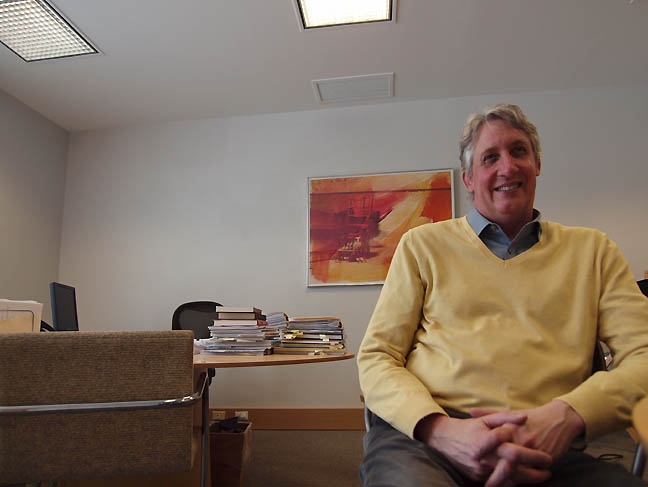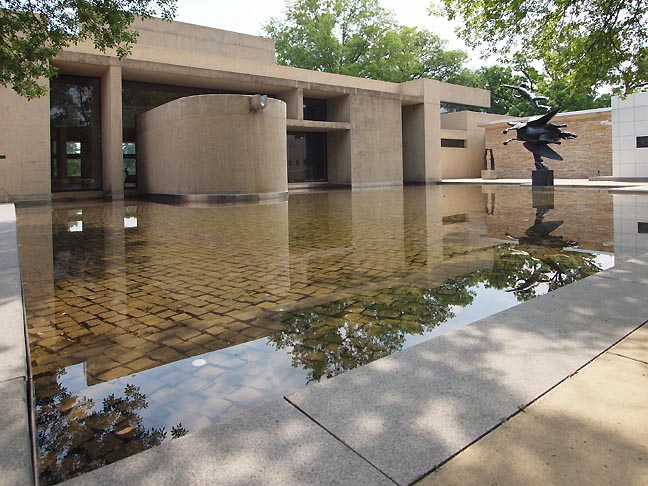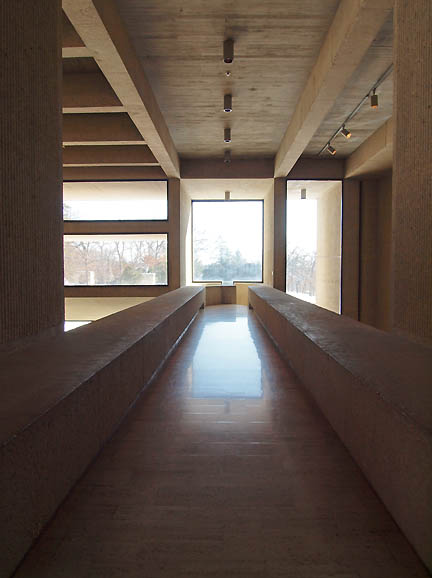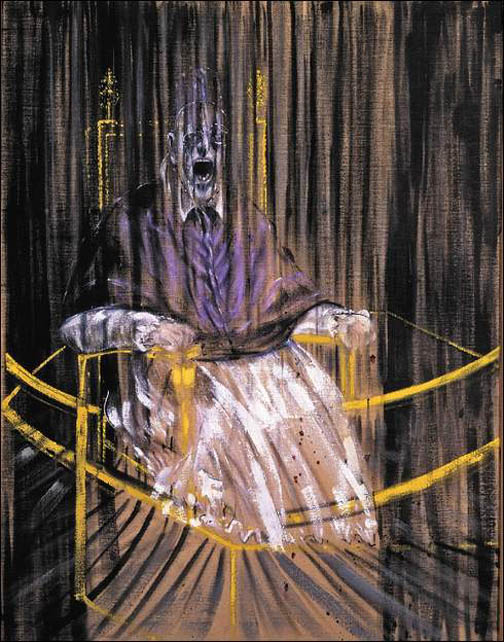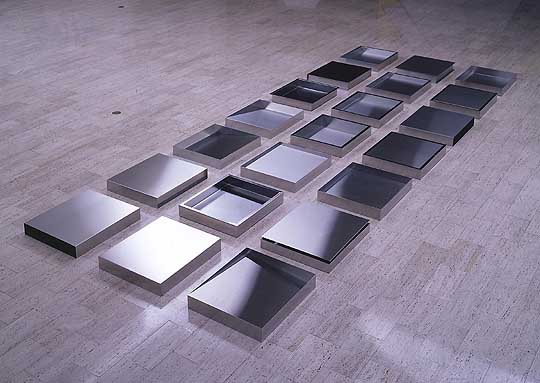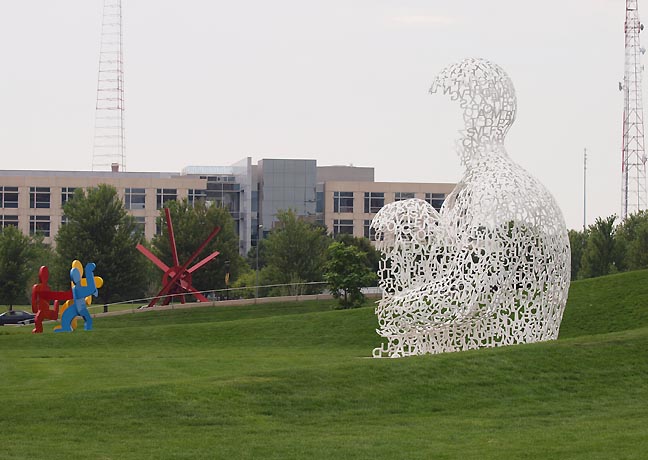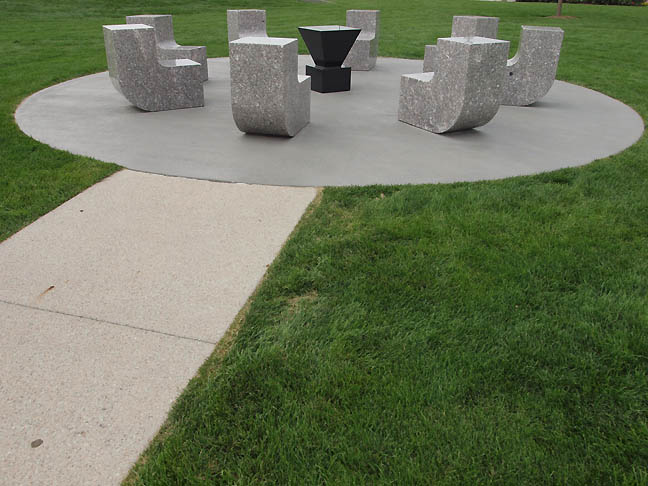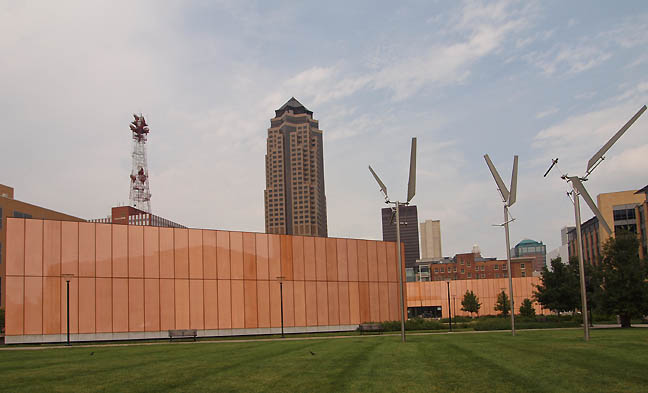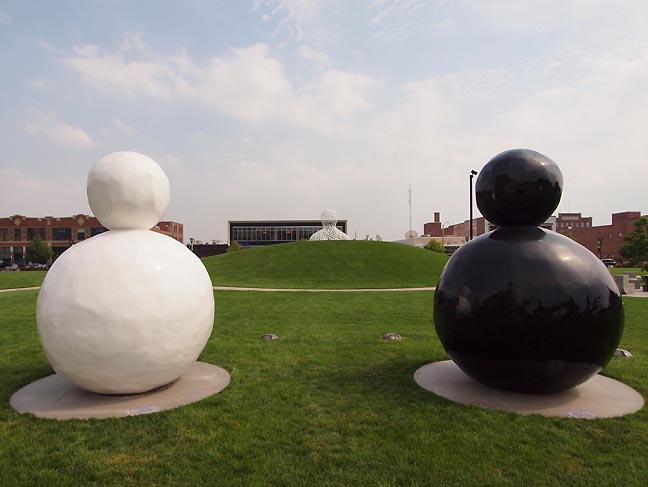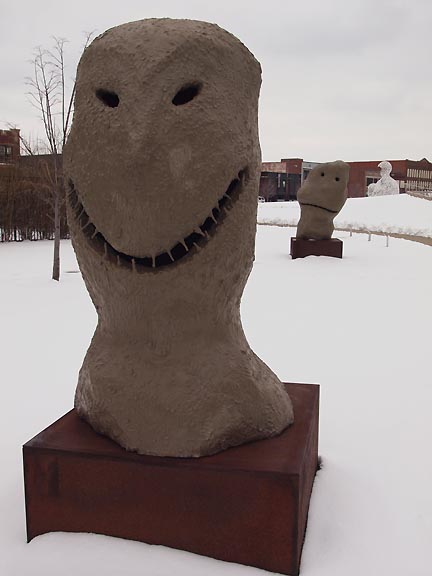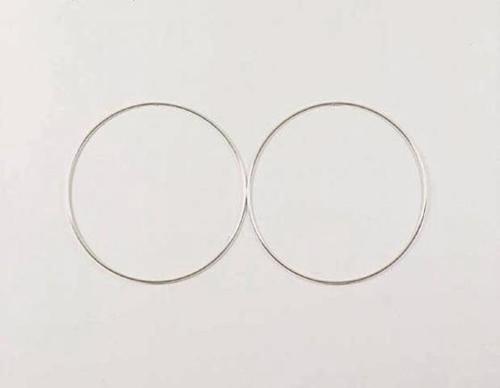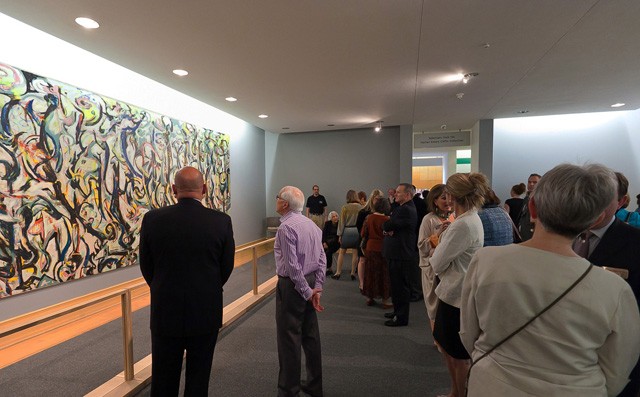
|
||
|
Portland art blog + news + exhibition reviews + galleries + contemporary northwest art
|
||
Interview with Jeff Fleming of the Des Moines Art Center Portland may have over 17,000 artists (according to the census) and a hyperactive alternative scene but out here on the West Coast we still have a lot to learn about building and maintaining art institutions (See MoCA). In Portland, the artists as a scene create most of the civic art energy but there is a lot we can learn from other places, especially even smaller cities that do things exceptionally well. Des Moines Iowa is one of those places... they don't just have community they have one that insists on excellence. The Des Moines Art Center with its world class architecture and contemporary collection is certainly their crown jewel so (disclosure) when my significant other had her second exhibition there earlier this year I took the opportunity to speak with their director Jeff Fleming. Fleming has a real passion for art that is coupled with a great deal of connoisseurship and discretion, which is why he is one of the most admired museum directors at one of the most admired (and focused) art museums in the country.
Jeff Jahn: What a pleasure to finally get to speak with you, a lot of museum directors that I have spoken to over the years really admire what happens here. From the first time I visited this museum I was really struck with just how good the collection was, even how consistently good and fresh the pieces felt in the galleries. It brings up questions about smaller cities in so called flyover states.... if you have something good how do others find out about these gems that are frankly hidden right out in the open? In particular, so many Midwestern cities have such great things... they aren't New York or on the West Coast yet these museum have a serious value set that might be somewhat of a dieing breed. Sometimes on the West Coast I sense more emphasis is placed on just getting people inside the doors and selling tickets. Whereas here you've done away with the admission fee and I am interested in how something so excellent and accessible came into being in a small but still important city like Des Moines. Are there lessons we can learn on the coasts? Jeff Fleming: There are many questions, so we'll just target some of them. One of them, I don't think this community takes us for granted. They do appreciate us, at least as far as I can tell and they do acknowledge that this is a place of quality and they are very proud of us. It is a wonderful thing. We have both been in several communities and I have lived in a place where the community did not necessary appreciate the institution. I see this as a very very different place. JJ: How did that occur? JF: Well from day one there was and continues to be the very best you could be in order to participate on a global scale. So there wasn't a "let's be the best in Iowa" there was the intention of, "let's be the best in the nation," so let's participate at an international level in a sense of quality. So that has been the character certainly in the case of this institution from day one but it also reflects the character of this community.
JJ: Iowa is a state full of great colleges, is it the education that puts such an emphasis on relevance and quality? JF: I think it would be in part that and all of these are generalities. Of course I do think this is an educated community. Historically it has been at the high level of states rankings but also I think is is... and I wrestle with this term... I want to say a "sophisticated community" but I don't want to mean that in an elitist sense. Instead, it is a sophisticated community in terms of participating in the world. Many here are well traveled, well educated and have a desire to know what is going on beyond their doors and want to bring it here to participate with the community here. That is what I mean by that term. We do have free admission and from the beginning that was part of our vocabulary and our philosophy... wanting to make this institution, fine arts and school as accessible as possible has always been a part of our history. It seems to becoming part of our brand now... now that we are fully accessible and free to everyone. It seems to be working and that is exciting. JJ: From conversations in Des Moines over the past week I can tell that everyone seems to know about the museum and has a lot of pride in it. They even know what show is up. Around Portland even Seattle and LA museums seem to be less to be part of the civic discussion. Sure, we have more coffee shops and great weather too but it is like everyone is off pursuing their own bliss be it food, hiking on the beach or green living with solar power to take time to make the museum central to their civic experience. I feel like the West Coast is all about the frayed edges and the Midwest has a belief in a strong core with follow through. Maybe I'm just nostalgic for my Midwest upbringing? JF: From the very beginning, we are a very young institution 65 years old, this year. There was an organization called the Des Moines Fine Arts Organization that existed before the Des Moines Art Center came into reality. But the leaders of the community in the 30's and 40's wanted to create a world class art center and a world class art museum because they wanted to be a world class city. And this is very important, they thought that having a world class art center/world class art museum would place them in the class of being a world class city and that continues to this day. They look at the arts as adding a vitality and vibrancy to a community. I can tell you one great story, he was a CEO of a grocery store and we were asking for money and asking for participation and he banged his fist on the door and he said, "Art Center is just like a sewage system." And I was thinking, "ewwww this isn't going well." Then he said, "The city can't live without it." (laughs) ...so that was absolutely wonderful that yes we are part of the infrastructure of the city. That a city cannot exist without having a world class museum as a part of its core and this was coming from someone who is not in the museum world. JJ: it's a tremendous validation... I've always felt like cultural institutions are like an instrument cluster giving abstracted readings and feedback to the rest of the system... yeah you could fly without an altimeter and airspeed but it makes landing and general flight a lot more dangerous. JF: They see the importance here... and getting back to the history in the 30's and 40's part of the plan for making a world class museum was hiring a world class architect, Eliel Saarinen. They searched him out and selected him because he had this new vision. He had a modernist vision that could have been something different but they selected purposefully a very modernist structure. And it continued with I.M. Pei and it continued with Richard Meier.
JF: It is incredibly light and airy at the same time while being heavy and very masculine. Simultaneously with choosing these architects during the first years the museum didn't quite know what it wanted to be... for example it bought a wonderful Goya painting which is somewhat out of our collecting philosophy today although you could say he was a pre-modernist and it was still the notion of acquiring quality work. Then very shortly after the establishment of the museum they decided, I believe very smartly that this should be a focused museum and focus on modern and contemporary work, which keeps shifting through time as the definition of contemporary does. So "the art of our time" might be a better way to describe the focus.
JF: But that's the idea with our purchases of works of art... sometimes that works with gifts and sometimes that doesn't. JJ: I've noticed you seem to track artists and choose to collect at just the right time. For example Fred Wilson whom you just added. It is a very strong piece of his and though he hasn't had say a MoMA retrospective there is this sense that he is super respected and at the top of his game right now. JF: I've known Fred for a very long time and did a project with him in the 1980's but certainly as a curator and then director one keeps one's eyes open, watching what they are doing and seeing if there is a time that what they are doing is appropriate to the collection. As with any other museum there are limited funds for acquisitions so we have to be very very smart or (laughs) very timely. Sometimes we get it right, sometimes we don't but that is part of the game but I think we get it right more than we get it wrong. JJ: Well it appears like you keep an edge, so you aren't buying names and what scraps are left over after the bell curve crests. In this way your reputation does help but it is also that tracking of artists. There is a tradition of "getting it right" and it puts pressure on the institution to not coast. For example with the Noun collection which focused on female artists in the 50-60's hen so much of the art discourse was fixated on men like Pollock then Warhol and Judd... Louise Noun's collecting was incredibly prescient. JF: Im not certain if it is any different than any other community but yes there seems to be a reciprocal relationship with the community and the museum... where the institution because of its focus has created or sustained an interest in the community for focused collections on a very high level. They do it on a very smart level. For example we have over 180 works from Louise Noun. She started to collect broadly and then focused it on avant-garde, modernist women like Agnes Martin and Eva Hesse and she did an extraordinary job. But we supported it or fed it and in tern it came back to us so that has happened time and time again in this community. JJ: It does seem to be an ethos... maybe not just to Des Moines but to the Midwest. While eating at the Drake diner today I overheard the word "pointless" as a pejorative over and over again and it struck me because on the west coast you never hear someone using that word... they just accept things (Major West coats cities at least are ultra tolerant) and instead I overhear the use the word "random" in similar situations but it isnt even a pejorative, more like a shrug. For example "That was random"... which doesn't make much sense to me logically because there usually is a causality. Perhaps we don't like to take responsibility for things as seriously on the West Coast as they do in the Midwest. Maybe it is just different? I missed that frankly the idea that there was a point to make with every activity. An ethos of making every project meaningful.
We have marvelous collectors in John and Mary Pappajohn and they were generous to give us a sculpture collection to be placed in a public space downtown. It broadens the scope of the art center, places the highest caliber work in the public domain and it changes the landscape and character of the community... which is exactly what we wanted to do. We began that project with 14 works within a newly created green space downtown. At first we were going to simply plot them in that flat green space but we quickly determined that was not good enough, that we had to be better. Literally the park was finished in 2006 and we started changing it in 2007. This was a new park that we were proposing to change but the city embraced it immediately and we raised funds in 2008 and 2009, which of course was not a good economic time period. But we raised the money in 6 months because the "Community" comprised of foundations, corporations and individuals saw the potential for change in the character of the community through high quality work. So we transformed what had just been transformed there. The number of works grew to 25 and we have added two works since and there are talks of adding another so we are now at 27. Once again it is all in the ethos of the premier works by important artists such as Yoshitomo Nara, Di Suvero and Plensa. The Scott Burton is beautiful, beautiful.
JJ: It seems to be transforming the Gateway district I think it is called? JF: Yes, there is am eastern gateway and the western gateway. JJ: And there is a David Chipperfield library right down there within eye shot of the sculpture park. JF: Which is another example of having to have the very best from the most significant practitioners. In that case architecture.
JJ: There is complementary ethos with a similar level of follow through. When I talk to people and they ask me about Des Moines I tell them that they have what Chicago and Houston have but with a neighborly element that isnt snooty at all. Des Moines is a little bit like a smaller version of Chicago, which has the best public art of any city since Rome... but without the corruption and empire building.
JJ: It is rare because it is a crossroads of institutions reinforcing one another with challenging, engaging quality. Common logic would not think that the library and the art museum could reinforce one another but that is exactly what has happened in downtown Des Moines. You get that in Chicago but it is more touristy in the case of Des Moines one gets the sense that it is the residents and people downtown on their lunch break who get to engage great art and architecture without making a special trip to do so. JF: That is what I'm talking about... there is this energy and it isn't just at the art center, it is broader than that. We are part of it and it has altered the character of the city. JJ: I even saw there is a new ice skating rink next to the river. JF: Ive lived in Des Moines for 14 years and it has totally transformed in that time period. It is amazing. JJ: Yes new bridges including one by Miguel Rosales... The big new pedestrian/cycling bridge. It is very impressive with its 2 curved paths that give you nice views of the water or the city. It goes deeper than mere pride or vanity there seems to be an emphasis on quality as a way to visually and spatially reinvest a different kind of capital in the people who use and view it. JF: I don't see it s vain at all either, for example the performing arts/civic center does theater, music... etc. etc. There is a plaza out front called Nollen plaza, it is many years old now and we are in the process of renovating that. But immediately public art had to be a part of that renovation, without question on anyone's part and again the selection of the artist had to be of the highest highest caliber on an international level. So that is part of the conversation and dialog of this community, which is extraordinary. JJ: Is there a percent for art that must be spent on any renovation? JF: No JJ: see that is interesting because in Portland we have 2% of the budget for a building has to be spent on art. The results are quite mixed. Sometimes it is great and other times its merely quirky or uninspired because it goes through a committee and that process itself doesn't get held responsible for superlative quality or concept... I feel the emphasis on process absolves it of a more critical focus on success, deep intentions and final relevance. There was a particularly bad moment in Chinatown where they didn't get meaningful feedback from the Chinese community and installed upside down stone dragons with collars around their necks... which metaphorically is NOT what you want to do. More recently they spent millions on some quirky plant like street lights but they are so hokey and it is right in a major arts district. There should probably be a moratorium on salmon and beaver sculpture too. To be fair they also are doing a Jorge Pardo that looks excellent but it sticks out like a diamond in a sea of Pacific Northwest caricature. We are improving but it seems ad hoc.
JJ: Not to get you in trouble but is there a message from the mayor's office and city government regarding the role of art? JF: Certainly I sense that there is that support from the city council and city manager. It is called the Des Moines system in terms of it as a mayor with a city manager and city council. But it is my sense that they would have it no other way than incorporating public art. In fact there are now talk fro the Mayor of public art being included along the interstate and that's coming from him not this (pointing to the building) arts community. JJ: No you don't see art along interstates very much. JF: Des Moines is in a process called Capital Crossroads in terms of metro regional development and one of the categories is Cultural Capital. I believe there are ten in all and we are in the process of developing many initiatives within the Capital Crossroads initiative. One of those components in the sub component (laughs) is cultural tourism. Its possible because they know we already have high quality work, pulling people off 235 or I-80 as they pass by the city but to bring in visitors from elsewhere. Approximately 25% of the visitors to the Des Moines Art center are not local. I dont know how that compares? JJ: That would be a very good question, obviously in New York most of the people at MoMA are not locals but that is something different. Cities like Austin, Minneapolis, Portland, Seattle, Beatonville or Kansas City are not the same as LA and New York. Besides New York's museums are tough to compare against anything other than London and Paris all are imperial capital Weld Stadts. JF: The city of Des Moines is not necessarily a huge tourist destination but we can change that perhaps by relying on the cultural strength here. JJ: I definitely plan my travel to include trips to the various museums. I will plan a layover so I can take in whatever is available. Houston, Denver, Minneapolis, Kansas City, St Louis and Milwaukee are all great for that. I dont see museums as vaults but as concentrated places for contemplation. The Des Moines Art Center definitely holds up well against anything say in Houston or Minneapolis but it is less known. ...I'm doing my part here. Were there any other initiatives that Des Moines has that night be of interests to other cities as a model? JF: I do think this particular city appreciates its cultural organizations and promotes, uses and supports them. It is a very philanthropic community so the knowledge that they are important is wonderful. The knowledge or belief that a sculpture park could transform a community is now a part of the mindset of the community. The notion that whatever we do, be it performing arts or visual arts or opera is the intent of being the very best we can be and to participate on a global level. That is not to diminish the local at all and each year we do have an Iowa Artists show and respond to the contemporary work in the state. We do have works in the collection from Anna Gaskell, Rita Mcbride, Alex Brown and others. So certainly we participate on that level but also to participate in the world at large. I also wanted to add that Des Moines does seem to be doing a good job now, though it was difficult at first of being one of the best places to be a young professional or to raise a family or the best place to do business and there has been a concerted effort to retain its young people. But it is also to have a vital community where businesses want to grow and families want to grow or young people want to establish themselves. And the city realizes that the cultural organizations a major portion of all that and it embraces that discussion. And it seems to be working though of course you are never there but it seems to be going in the right direction
JJ: To me Des Moines makes it look easy, which of course means it was the exact opposite and it was likely very very difficult to make the decision to do things the hard way... ie instilling an ethos of doing things that stand up to and matter in a global context rather than trying to grab low hanging fruit and doing things the easier more expedient way. All cities exist within a marketplace for talented people and they can attract and retain them through stimulation and acknowledgment... but also by having standards that translate in that international marketplace. Fresh creative ideas and solutions are the lifeblood of civilization and you try to make your civic zone or city as appealing as possible. An excellent curator in one city generally is excellent in another one provided the support is there. It is all how a city supports and engages its human capital both as institutions and individuals. It is like a recruiting tool and culture is a crucial amenity. JJ: Anything else? I noticed you do a lot of cross programming like a screening some of the shorts for the Oscars that people never get to see for an Oscars night and have a show of Hollywood related work at the same time. JF: We had three screenings, one was documentaries, then animated shorts and live action shorts. In fact each one was sold out. There is a large film community here and as you said who gets to see all these less mainstream things that are nominated for the Oscars so it has been incredibly well received. Often we do a related exhibition with these initiatives and there was a very small jewel box show with Edward Hopper and Andy Warhol. It is just another way to re-contextualize the collection all of the time. We are wonderful in that we we are a modern and contemporary museum so we don't have to provide an encyclopedic experience but a contemporary one. I love encyclopedic museums but we don't have a curator of American painting or a curator of European painting so we don't have those divisions. Our galleries are not Greek galleries, Italian galleries or Roman galleries. They are not based on paintings, sculptures or prints. All of the ethnicities, disciples and time periods merge so it is a more human dialog not a segregated or categorized one. So we can have an African work from 1927 right next to an Ai Weiwei sunflower seeds. So that is the dialog that I am interested in. I love the conversations between works no matter where they are from or what materials they are made of.
JJ: I loved seeing the pile of Ai Weiwei sunflower seeds installed near the Felix Gonzales Torres piece. Torres is most known for his take away candy pieces but yours is the really great double circle of silver... both of which have this reference to infinity or at least vastness that cannot be depleted. Both Torres and Mr. Ai both spent a key formative period in New York City in the late 20th century and had a poetic approach to materials that signified a larger social issue. It was so nice to see them together and Ive never seen it done at another museum before. It is very sensitive. JF: We do like those, perhaps not odd but interesting combinations. You'll see the David Hammonds with the Joseph Beuys Chalkboard and the Anselem Keifer. There is a visual connection, and I call it the aura of a gallery. There's a Frankenthaler with a Rothko and a Brice Marden. It is the atmosphere and character that work together that I so enjoy. We also have Andy Warhol Portraits of the Mona Lisa with a Henry Moore and they are all portraits. And if you look at the Warhol as a collection of colored blocks or minimalist forms then it matches aspects of the Sean Scully's walls of light. Those are the conversations that I like. JJ: Its like James Gobel's Leisure Time painting right next to the Alex Katz and it is a hilarious juxtaposition. JF: and then you have Vik Muniz and Chuck Close nearby as well and they are all related. JJ: It is so important the way 3-4 objects are in dialog with one another. It isnt just a cavalcade of examples the work is in conversation. I've noticed you don’t have just a gallery devoted to important female artists your Yayoi Kusama is near the Eva Hesse but there is also an Anselm Reyle in the mix. There is no ghetto of classification its a contemplative experience as those three artists all have a way of taking the mundane and everyday and through arrangement and augmentation create art which changes the raw materials they are comprised of. Since each is different you see the divergent decisions and convergences in relief of one another. Giving each enough space and not too many voices in each room is wonderful and generous to both the art and the viewer. The first time I visited the museum was for the Richard Tuttle retrospective, which I reviewed. JF: Really? JJ: It was fantastic because the character shifted between the Saarinen and Richard Meier wings. But the best part was the point where Tuttle took a very difficult to use Meir space behind a wall... a traditional painting or sculpture could not use it and he placed a piece of string with a Chinese finger puzzle. It was thrilling how sensitive it was. I saw the show at three venues and this was my favorite because it engaged the idiomatic nature of the space with idiomatic solutions. JF: I hadn't realized that Saarinen had laid out the wing he designed on a six foot grid but Richard picked up on it right away. JJ: It is refreshing because in museums the sensitivity for well installed work and the needs of the art is under pressure to move visitors through the gallery or to produce blockbusters. Perhaps not having an admission fee removes some of that pressure.
JF: But we did have a blockbuster, Jackson Pollock's Guggenheim Mural. It was so exciting for us and though there is nothing wrong with Monet, I'm just using his work as an example... there is no need for us to do a Monet show. But there was a need to bring that great painting to a larger community , particularly in the State of Iowa (normally it resides in Iowa City at the University of Iowa's art museum). And it became a blockbuster for us. It is a difficult painting to exhibit (it is Pollock's largest work) and not well known in the larger community as a great work residing in the state. Yet it became an extremely popular exhibition and that is really exciting. JJ: What is so special is that it was this moment of awakening for Pollock and American art in general on the international level. It signifies the ambitions and reality of an age when the USA became a leader in all things. Soon after the Axis powers of WWII capitulated and Pollock's drip paintings became the cultural calling card but that mural is more like Les Demoiselles d'Avignon. It changed the scale and immersiveness of abstract paintings. I had never seen it before and it is amazing how close you have to get to it to read it. It is Moby Dick... painted at a time of struggle. Normally art doesn't develop well during wars... art needs peace but because Pollock was 4f (unfit to serve) he was channeling this urge to take part in something much bigger than himself. He succeeded wildly... and like Picasso and Les Desmoiselles d'Avignon he spent several years trying to figure out why it worked. It was a key that unlocked his work and because of that it doesn't need to be accompanied by other works... there is so much in just that one work. JF: I love it, I love it... JJ: in illustrations one doesn't understand how tactile the mural is. JF: sure JJ: and because it was here suddenly everyone rounded up the kids and brought them in. JF: to see what it is all about. JJ: and did you have to promote it extensively or was it word of mouth? JF: well we certainly did it but there weren't any billboards and we didn't take out an ad I n Art News or anything. JJ: it is true, when I was in town I simply knew it was here, everyone was talking about it. And it didn't move that far just 100 miles or so? JF: Yes JJ: Well it was wonderful and it has been such an honor talking shop with you after visiting this museum four times but loving it. It does have a different character than the west coast which is very me me me yet detached and the east coast which seems to be more society pages driven. The Midwest seems very sensitive to being about appreciating work for itself and here in Iowa it isn't just pride in the community there is a very open sense of enhancing it in a way that stacks up elsewhere. JF: There is a community spirit here, different than any other I have lived in. JJ: Is there anything else? JF: well there is a hard cover catalog that we are working on and the same things that are happening in the galleries are happening here (flips though the pages of a pre production copy). The architecture is chronicled just as the works in the collection, Iowa artists and there will be video and film as well. On each of these there may be a major sculpture but a work on paper as well. There is the Kiefer, Hesse and for Kippenberger there is the stationary work. Again not having a hierarchy but more of a time period of when the works came to the museum. JJ: it was nice the way you collected a Richard Tuttle that spoke to the early Agnes Martin. They are both wooden skateboardy, surfboardy forms that were early for each of their careers. JF: 1989 for the Tuttle and Agnes' is very early, she did very few sculptures. (flipping through the book) there's Ana Mendieta and here's an early Gottlieb. Everything is organized by decade and because the architecture is considered a work of art it is included as such. This Liz Taylor was commissioned by a Des Moines Businessman and this is Roy Halston's Warhol, a designer who also gave to the museum's collection. Photography gets equal billing too, so no hierarchy in the book either. There are these wonderful (Matisse) cutouts... with the Jazz Series. It is very exciting. JJ: and there is also the greenwood park area surrounding the museum with Mary Miss etc. Is that part of the collection as well? JF: Absolutely, and here's the Richard Serra (pointing to the book) JJ: I think when the book comes out a lot of people will be very surprised if they have never been here.. Let us know when it comes out. JF: Hopefully it will be very soon... it is almost done. Posted by Jeff Jahn on September 14, 2013 at 0:30 | Comments (0) Comments Post a comment Thanks for signing in, . Now you can comment. (sign out)
(If you haven't left a comment here before, you may need to be approved by
the site owner before your comment will appear. Until then, it won't appear
on the entry. Thanks for waiting.)
|
| s p o n s o r s |
 |
 |
 |
 |
 |
 |
 |
 |
 |
 |
 |
 |
 |
 |
 |
 |

|
Site Design: Jennifer Armbrust | • | Site Development: Philippe Blanc & Katherine Bovee | |


